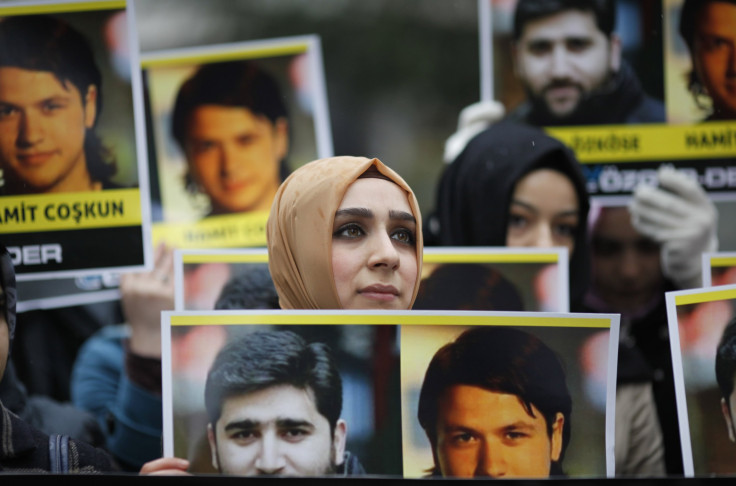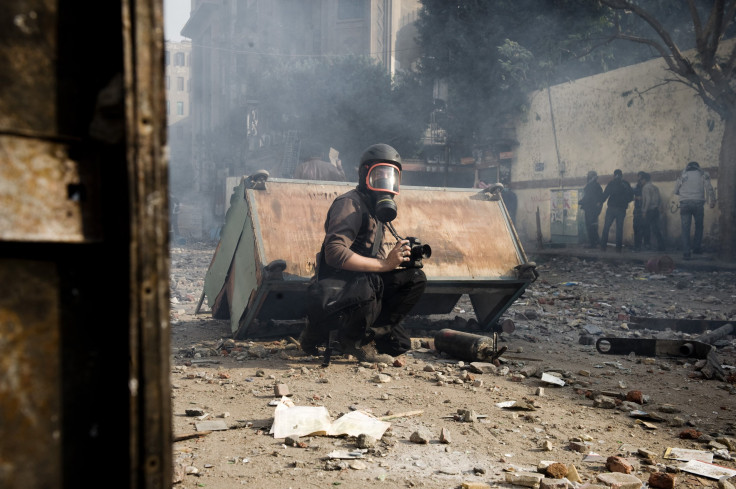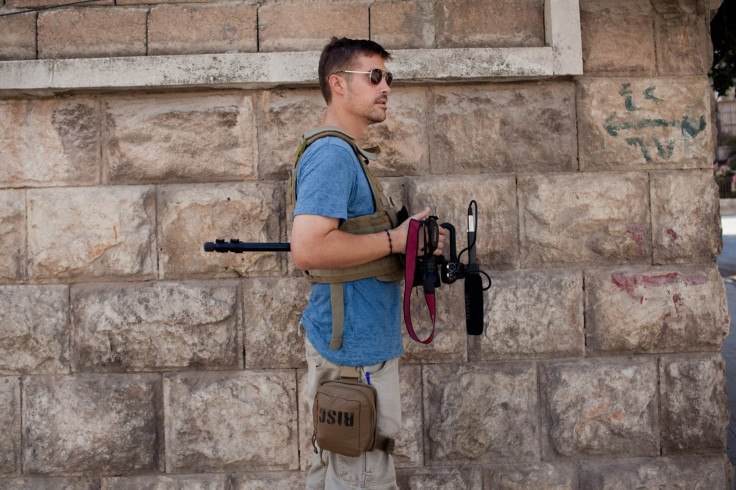Syrian Conflict: The Assad Regime, The Free Syrian Army And Al Qaeda - And The War Against Journalists In Syria
On Aug. 13, 2012, two days after his 31st birthday, freelance journalist Austin Tice was preparing to travel from near Damascus, Syria, to Beirut, Lebanon. What happened next is known only to him and his abductors. For everyone else, there is only a 47-second YouTube video that appeared a few months later in which a group of turbaned gunmen take Tice, blindfolded, to a rocky hillside and force him to recite a Muslim prayer, after which he says, breathlessly, “Oh, Jesus. Oh, Jesus.”
Though Tice was alive when the video was made, everything else is uncertain. The scene appears to have been awkwardly staged, leading some to believe it was fabricated to make it appear that Syrian rebels were holding Tice when he was actually in the clutch of government forces. The sad truth is, we may never find out Tice’s fate.
But this much is incontrovertible: Dozens of journalists have been abducted and murdered in battle-weary Syria during the past two years, by both sides of the conflict. The government of President Bashar al-Assad has targeted journalists to silence media coverage, while rebel groups seek ransoms, publicity or a chance to punish people they view as representing their ideological enemies. Without reporters and photographers, the outside world would have no way of knowing the truth about the war and its atrocities, including the gassing of civilians, yet because of the risks involved, many news organizations no longer cover the conflict, or if they do, they rely exclusively upon freelancers who dare to enter the country on their own.
In all, at least 42 international journalists have been kidnapped in northern Syria since July 2012, according to the Rory Peck Trust, which assists freelance journalists and their families. Some have been released and a few have escaped captivity, but 14 -- and perhaps more -- remain unaccounted for.
Added to that, the nonprofit Committee to Protect Journalists (CPJ) says that at least 32 journalists have been killed in Syria in the last year, for a total of about 50 since the start of the civil war, some of them deliberately targeted. Perhaps 15 more are imprisoned on fabricated charges. For all those reasons, CPJ ranks Syria as the most dangerous country in the world for the press, and it is growing more perilous for journalists with each passing day. When considering the estimated number of missing journalists, “The phrase ‘at least’ is important,” said Jason Stern, a Mideast and North Africa researcher for CPJ. “As bad as our data makes it look in Syria, it’s actually worse.”
The same month that Tice was imprisoned, the al-Nusra Front, a Syrian rebel group affiliated with al-Qaeda, announced that it had beheaded Damascus TV host Mohamed al-Saeed, who, though his death is unconfirmed, has not been heard from since. Meanwhile, Jordanian reporter Bashar Fahmi and Turkish cameraman Cüneyt Ünal, working for the U.S. government-funded broadcaster Al-Hurra, were reported missing in the northwestern city of Aleppo simultaneous to the killing of Japanese journalist Mika Yamamoto in a firefight there. Ünal was later released, but Fahmi’s whereabouts are still unknown.
Among the other journalists who have been abducted are reporters and photographers from Belgium, France, Germany, Italy, Poland, Spain, Syria, the Ukraine and the U.S. Nine Americans have been kidnapped, including Richard Engel, a correspondent for NBC whose abduction was much publicized after the fact. Engel was kidnapped by Assad loyalists in December 2012 along with five team members, a Syrian rebel commander and a bodyguard. The rebel commander and bodyguard were killed, but the NBC team was saved by rebels who escorted them to the Turkish border. (Click here for a list of journalists known to have been kidnapped or imprisoned in Syria.)

Maddening questions remain about the fates of the missing, including whether they are still alive, and if so, who is holding them and why. Peter Bouckaert, emergencies coordinator for Human Rights Watch, told International Business Times that there have been at least six unreported abductions in the last four months, several involving more than one journalist. The majority of those who have disappeared are freelancers who lack the support networks of major news organizations, and many abductions have not been reported due to media blackouts imposed during negotiations over their release, Bouckaert said.
The uprising in Syria and the resulting civil war have been dangerous for journalists from the outset in 2011, but in recent months the government -- long repressive of press freedom -- has ratcheted up its attempt to suppress news by barring entry to most international journalists and controlling local news coverage, including abducting or arresting journalists who smuggle themselves into Syria, typically across the borders with Turkey and Lebanon.
With Western media outlets effectively barred from covering the war, a cadre of Syrian freelancers and citizen journalists have attempted to fill the gaps by photographing, videotaping and reporting on the bloody conflict. As a result, they have suffered the most. According to CPJ, 90 percent of the journalists who have been killed were Syrian, and many were specifically targeted. Among the higher profile citizen journalists killed was Fidaa al-Baali, a passionate activist and observer who was frequently interviewed by international media, including the New York Times, who died in July from shrapnel wounds sustained during government shelling in Damascus. As the New York Times noted, “Al-Baali never stopped trying to document the conflict -- not when his brother, a rebel fighter, died in battle; not when security officials, trying to pressure him, arrested his father; not even when the rebel battalion he was embedded with unleashed a mortar attack that killed his fiancée.”
The best known among the journalists murdered by the government was Marie Colvin, an American working for the U.K.’s Sunday Times, who had told colleagues she believed the Assad regime would do anything to prevent stories and pictures from getting out that could increase the likelihood of foreign intervention. Many believe the mortar attack that killed her and French photographer Remi Ochlik specifically targeted the media center in which they and other journalists operated.
Threats from rebels, too
The chief opposition to the Assad regime, the Free Syrian Army, is moderate compared to most Islamist militant groups, including those associated with al-Qaeda. Yet, all of the rebel groups have committed atrocities of their own against journalists. Anti-Assad fighters kidnap journalists for a variety of reasons, including anger over media portrayals, a belief that all Westerners are spies, the desire for attention or, most often, to negotiate for ransom. The most dramatic rebel killing was of Iranian TV reporter Maya Nasser, who was shot by a sniper while on the air as he reported on bombings in Damascus.
Italian journalist Domenico Quirico was kidnapped by a renegade rebel group on April 8, and upon his release 150 days later, he said that most of his captors were so brutal they made the al-Qaeda-linked fighters among the group that held him look good. In his account of the ordeal for Italy’s La Stampa newspaper, Quirico, who had previously been abducted and released in Libya in 2011, wrote that his captors were mostly “mixed-up young men” caught up in a revolution that had been corrupted by “banditry and fanaticism.” Among them, only the al-Qaeda–affiliated al-Nusra Front operatives treated him and captive Belgian reporter Pierre Piccinin de Prata with a measure of respect, he wrote. The others seemed more interested in tormenting them and getting money and weapons, and they spent much of their time lounging on mattresses, smoking and watching old black-and-white Egyptian movies or American wrestling matches on TV, he wrote.
At the time of his capture, Quirico was traveling with a convoy carrying supplies from the Free Syrian Army that was intercepted by two pickup trucks full of masked men. “They made us get out, took us to a house and beat us up, claiming to be police officers working for the regime,” he wrote. Soon after, it became clear that they were Islamist militants opposed to Assad. During his ordeal Quirico was subjected to two mock executions, and he and Piccinin twice tried and failed to escape, at one point spending two days on the run, which only worsened their treatment once they were recaptured. Still, the two lived to tell the tale, and because one of their captors allowed Quirico to make a phone call, they were not completely unaccounted for during their captivity.
About six months ago, the al-Qaeda-linked Islamic State of Iraq and Syria, or ISIS, entered the Syrian conflict, which has added a new threat for journalists and a new level of difficulty for those who would attempt to negotiate the release of kidnapped journalists. Groups such as Human Rights Watch usually work through intermediaries who are familiar with the rebels. Yet many of these intermediaries have no connection with ISIS or they are afraid of the group, which has also threatened to attack members of the Free Syrian Army.

Surviving in a conflict zone
Conflict journalists generally fall into three categories: Citizen journalists who have been thrust by circumstances into the fray, and who are typically armed with little more than smart phones and social media accounts; seasoned veterans of conflicts such as the wars in Afghanistan, Liberia, Libya and Iraq; and less experienced, usually freelance journalists, whose primary qualification may be the desire to give voice to those caught up in armed struggle, or who want to experience the thrill of watching history unfold or the adrenaline buzz of surviving extreme circumstances. Experienced reporters usually try to assess the dangers, decide what level of risk is acceptable, and return to a safe zone once they reach that threshold. The problem with a complex and confusing war such as Syria’s is that it is often impossible to clearly assess the dangers, which has the effect of invalidating the rest of the plan. For the less experienced, the dangers are magnified. (Here's a first-hand account of the what it is like to be a female journalist in Syria from the International Business Times reporter stationed there).
There is also the question of who can be trusted. Historically, war journalists have embedded themselves with one side, which means the greatest threat comes from the clearly delineated enemy of that side. In Afghanistan, Western journalists were usually embedded with U.S. troops or their allies, making them the target of the Taliban and their allies. During the Libyan revolution, most international journalists accompanied rebels, and as a result, the danger came from Gadhafi forces, which were responsible for a mortar attack that killed British photographer Tim Hetherington and American photographer Chris Hondros in April 2011. In Syria, the threats are myriad and changeable. Journalists have been kidnapped or otherwise targeted by the Assad regime, by police and by a shifting array of rebel groups, many of which are in conflict with each other. “For even the most experienced journalists, this makes it almost impossible to evaluate and prepare for the risks involved,” Cantenys said. “When journalists do go missing in Syria it can be very difficult to know who’s holding them, and for what purpose. This is a particular concern and danger for freelancers who don’t have the backup and resources of a news organization when something goes wrong. Very often they fall into a black hole, which is terrifying for the their families and colleagues.”
In some cases, nonprofit groups and government entities have succeeded in negotiating the release of abducted journalists. Cüneyt Ünal, the kidnapped Turkish cameraman who appeared in a video during his captivity that ran on a pro-government TV channel, was released in November 2012 as a result of outside negotiations with the regime, the details of which -- like most such efforts -- were not publicly disclosed. The following March, the Syrian government released German journalist Billy Six after nearly three months, also as a result of secret negotiations. Around the same time, Anhar Kochneva, the Ukrainian journalist, reportedly fled her captors, though few details were reported about how it happened. The Ukrainian Foreign Ministry had previously announced that it would negotiate for her release, and news accounts reported that Kochneva’s captors had threatened to kill her if they did not receive a ransom of US$50 million -- an amount later reduced to US$300,000. Kochneva appeared in two videos in November 2012, pleading for her embassy to meet the demands of her captors. CPJ believes she was coerced into making the videos, in which she confessed to spying.
Other journalists who have been captured and released report having been treated roughly, even tortured. Alpeyrie, who was abducted by rebel forces near Damascus in April and released after 81 days when a benefactor paid a ransom, said he was physically and psychologically tortured. Schrier endured seven months of captivity in the hands of two rebel groups, during which he was beaten and his online identity was stolen, enabling his captors to empty his bank account and send emails posing as him. Schrier managed to escape on July 29 by squeezing through a basement window and seeking help on the streets of Aleppo, though an unidentified American with him was unable to get through the opening and remains missing, according to the New York Times.
The unknowns
Not surprisingly, the journalists’ abductions are extremely traumatic for their families, colleagues and friends. In April 2013, James Foley’s mother, Diane Foley, told IBTimes: “We really have no idea who captured Jim, or for what reason. So we don’t know who we’re supposed to be interacting with. That’s part of what’s frustrating, but we really feel that everyone has been trying hard to help us.”

In May, Global Post, which had employed Foley as a freelancer, concluded that he and another American, who many believe to be Tice, were being held by the Syrian regime in the vicinity of Damascus. That was partly confirmed in August when the Czech Republic's ambassador to Syria, who also represents U.S. interests there, announced that Tice, a former Army captain from Texas, was “alive and ... detained by government forces in the outskirts of Damascus, where the rebels were fighting government troops.” Syrian authorities have refused to confirm if they are holding either man.
Tice’s family maintains a website to share information about him, as does Foley’s family, who created the Free James Foley organization in May. The last time Foley’s family heard from him was in a text message in November 2012 in which he said he was on his way to the Turkish border. One of his colleagues, Clare Gillis, who had been captured with Foley while reporting from Libya a year before, was awaiting him at the border with photographer Nicole Tung when he failed to appear. Gillis notified his family, “And,” his father, Marc Tice, told Syria Deeply, a website that reports on the civil war, “every day since then has been, ‘OK, tomorrow we’re going to hear from him, tomorrow he’ll be released.’”
Marc Tice told IBTimes by email last week that the family has received no news lately about his son’s condition or whereabouts. “Austin has now been out of contact for over 400 days, and each day is at least as difficult as the last,” he said. “We are heartbroken at the horrible events of late August, and we hope the international effort now focused on eliminating chemical weapons will create momentum for a serious effort to end the conflict itself.” He said he also hopes that whoever the abductors are, they will recognize the “humanitarian goodwill which the immediate release of captive persons would create.”

Aside from reminding journalists about the dangers of traveling to Syria, and particularly to rebel-held northern regions, the only options available to media support groups are to stay in touch with journalists inside the country, offer support and, if a journalist is kidnapped, attempt to negotiate for their release. The Rory Peck Trust’s Elisabet Cantenys said her organization does not contribute to the payment of ransoms, but it supports the families of missing and detained freelancers with such things as travel expenses and living costs; monitoring the status of freelancers on the ground; and arranging for evacuations and treatment. The organization’s advice for journalists contemplating going to Syria, Cantenys said, is to exercise extreme caution, and “to think very carefully about the consequences for themselves, their family and their colleagues if they do.”
CPJ also encourages journalists to develop security and contingency plans, including check-ins with people who can notify someone if they go missing.
No organization IBTimes spoke with would detail how they might negotiate for a release, primarily because doing so would alert potential kidnappers to the possibilities for other abductions. After his release, Quirico did not describe the process by which he was released, nor have most others. In many cases, media organizations have withheld news about abductions altogether until after they are resolved. As Stern observed, merely reporting the facts of an abduction can be damaging, particularly if public revelations anger the captors.
Unfortunately, the targeting of journalists in Syria -- which Amnesty International characterizes as a war crime -- has succeeded by making it difficult to report the truth about the war. As CPJ senior advisor Jean-Paul Marthoz wrote on the organization’s website, “By sharply increasing the risk for reporters covering the civil war, they have forced news organizations to think twice before sending their staff to the battlefield.” In what he described as “a worrying development,” the U.K.’s Sunday Times has stopped buying photographs from Syria by freelancers due to the risk involved.
In explaining the newspaper’s decision, Marthoz noted, Sunday Times Deputy Foreign Editor Graeme Paterson said, “This is not a financial decision. It is a moral one. In the light of what happened to Marie Colvin we have decided we do not want to commission any journalists to cover the situation in Syria. The situation out there is incredibly risky. And we do not want to see any more bloodshed.”
Continuing the disturbing trend, news came on Monday that Marc Marginedas, a special correspondent in Syria for the Spanish newspaper El Periodico de Catalunya, had been kidnapped by “jihadist fighters” on Sept. 4. Marginedas, at 46 a seasoned journalist on his third trip to Syria since the conflict began, had entered the country with members of the Free Syrian Army and was traveling with a driver when they were stopped on the outskirts of the city of Hama. At the time of his disappearance, Marginedas had been interviewing rebels about their disappointment over the decreasing likelihood of a U.S. strike on Syria. His publisher delayed announcing his disappearance during efforts to negotiate a release, the status of which -- like Marginedas' whereabouts and the fates of scores of other journalists in Syria -- is for now unknown.
© Copyright IBTimes 2024. All rights reserved.






















